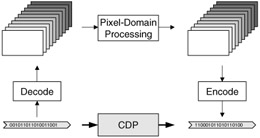2. Problem Statement
2. Problem Statement
Compressed-domain processing performs a user-defined operation on a compressed video stream without going through a complete decompress/process/re-compress cycle; the processed result is a new compressed video stream. In other words, the goal of compressed-domain processing (CDP) algorithms is to efficiently process one standard-compliant compressed video stream into another standard-compliant compressed video stream with a different set of properties. Compressed-domain transcoding algorithms are used to change the video format or compression format of compressed streams, while compressed-domain editing algorithms are used to perform processing operations on compressed streams. CDP differs from the encoding and decoding processes in that both the input and output of the transcoder are compressed video streams.
A conventional solution to the problem of processing compressed video streams, shown in the top path of Figure 40.1, involves the following steps: first, the input compressed video stream is completely decompressed into its pixel-domain representation; this pixel-domain video is then processed with the appropriate operation; and finally the processed video is recompressed into a new output compressed video stream. Such solutions are computationally expensive and have large memory requirements. In addition, the quality of the coded video can deteriorate with each re-coding cycle.

Figure 40.1: Processing compressed video— the conventional pixel-domain solution (top path) and the compressed-domain processing solution (bottom path).
Compressed-domain processing methods can lead to a more efficient solution by only partially decompressing the bitstream and performing processing directly on the compressed-domain data. The resulting CDP algorithms can have significant savings over their conventional pixel-domain processing counterparts. Roughly speaking, the degree of savings will depend on the particular operation, the desired performance, and the amount of decompression required for the particular operation. This is discussed further in Subsection 3.4 within the context of MPEG compression.
EAN: 2147483647
Pages: 393
- The Effects of an Enterprise Resource Planning System (ERP) Implementation on Job Characteristics – A Study using the Hackman and Oldham Job Characteristics Model
- Intrinsic and Contextual Data Quality: The Effect of Media and Personal Involvement
- Healthcare Information: From Administrative to Practice Databases
- A Hybrid Clustering Technique to Improve Patient Data Quality
- Relevance and Micro-Relevance for the Professional as Determinants of IT-Diffusion and IT-Use in Healthcare